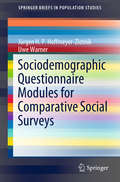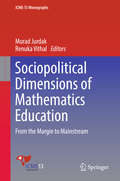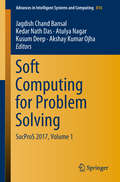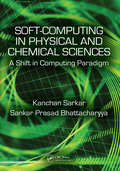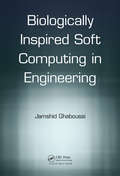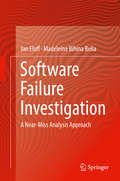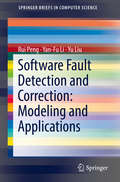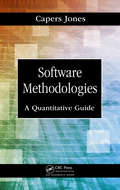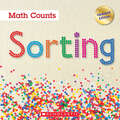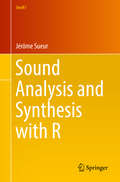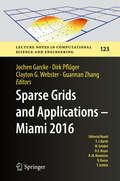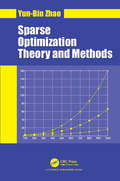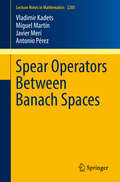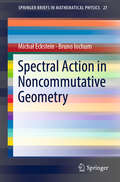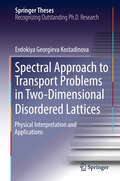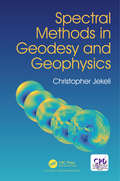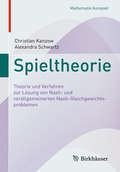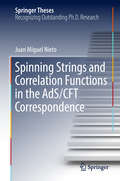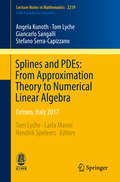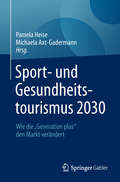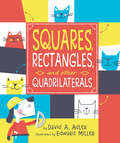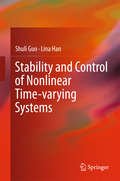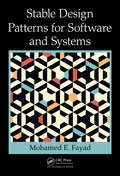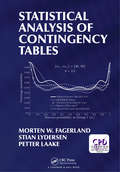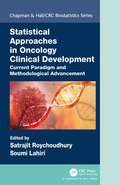- Table View
- List View
Sociodemographic Questionnaire Modules for Comparative Social Surveys (SpringerBriefs in Population Studies)
by Uwe Warner Jürgen H.P. Hoffmeyer-ZlotnikAbove all, this book focuses on the application of sociodemographic survey questions. Based on theoretical foundations, it addresses the operationalization of variables and presents socio-demographic questionnaire modules for within- and across-country comparative survey research. The book pursues three main objectives: to provide a thorough and comprehensive overview of the survey instruments currently available for the measurement of sociodemographic variables in cross-national comparative research; to offer the reader a set of harmonized international demographic standards; and to show how these standards can be implemented by the various parties involved in international comparative surveys – from the central project coordinators, to the researchers on the national survey teams, to the fieldwork agencies and their interviewers, to respondents, and eventually, to the data processing experts preparing the datasets for comparative analysis. The book offers a valuable resource for researchers, practitioners and students actively involved in producing and analyzing sociodemographic survey data. The typical readers will be social science researchers, qualified consultants and professionals interested in the field of (comparative) survey research. The book can also serve as a useful supplement to introductory textbooks on survey methodology and is suitable for Bachelor and Master students of the social sciences.
Sociopolitical Dimensions of Mathematics Education
by Murad Jurdak Renuka VithalThis book documents and expands on the diverse social and political dimensions of mathematics education issues, concerns, perspectives, contexts, and approaches presented in Topic Study Group 34 of the 13th International Congress on Mathematical Education (ICME-13). The book also argues for and promotes the mainstreaming of the sociopolitical dimensions of mathematics education through an ongoing critique and inquiry into content, policies, practices and theories. Accordingly, the main theme throughout the book is captured and illuminated by bringing voices from the margin to the mainstream. In this respect it is both aspirational and a reality, as evidenced by the increasing references to the sociopolitical dimensions in other areas of mathematics education—for example, in several of the plenary presentations at the ICME-13. The authors have reflected on their ideas with a view to orienting and enhancing research in the sociopolitical dimensions of mathematics education that is grounded in current education systems within their specific sociocultural contexts.
Soft Computing for Problem Solving: Socpros 2017, Volume 1 (Advances In Intelligent Systems and Computing #816)
by Kedar Nath Das Kusum Deep Jagdish Chand Bansal Atulya Nagar Akshay Kumar OjhaThis two-volume book presents outcomes of the 7th International Conference on Soft Computing for Problem Solving, SocProS 2017. This conference is a joint technical collaboration between the Soft Computing Research Society, Liverpool Hope University (UK), the Indian Institute of Technology Roorkee, the South Asian University New Delhi and the National Institute of Technology Silchar, and brings together researchers, engineers and practitioners to discuss thought-provoking developments and challenges in order to select potential future directions The book presents the latest advances and innovations in the interdisciplinary areas of soft computing, including original research papers in the areas including, but not limited to, algorithms (artificial immune systems, artificial neural networks, genetic algorithms, genetic programming, and particle swarm optimization) and applications (control systems, data mining and clustering, finance, weather forecasting, game theory, business and forecasting applications). It is a valuable resource for both young and experienced researchers dealing with complex and intricate real-world problems for which finding a solution by traditional methods is a difficult task.
Soft Computing in Chemical and Physical Sciences: A Shift in Computing Paradigm
by Kanchan Sarkar Sankar Prasad BhattacharyyaThis book can be regarded as 'Soft computing for physicists and chemists self-taught'. It prepares the readers with a solid background of soft computing and how to adapt soft computing techniques to problem solving in physical and chemical research. Soft computing methods have been little explored by researchers in physical and chemical sciences primarily because of the absence of books that bridge the gap between the traditional computing paradigm pursued by researchers in science and the new soft computing paradigm that has emerged in computer science. This book is the interface between these primary sources and researchers in physics and chemistry.
Soft Computing in Engineering
by Jamshid GhaboussiSoft computing methods such as neural networks and genetic algorithms draw on the problem solving strategies of the natural world which differ fundamentally from the mathematically-based computing methods normally used in engineering. Human brains are highly effective computers with capabilities far beyond those of the most sophisticated electronic computers. The 'soft computing‘ methods they use can solve very difficult inverse problems based on reduction in disorder. This book outlines these methods and applies them to a range of difficult engineering problems, including applications in computational mechanics, earthquake engineering, and engineering design. Most of these are difficult inverse problems – especially in engineering design – and are treated in depth.
Software Failure Investigation
by Jan Eloff Madeleine Bihina BellaThis book reviews existing operational software failure analysis techniques and proposes near-miss analysis as a novel, and new technique for investigating and preventing software failures. The authors provide details on how near-miss analysis techniques focus on the time-window before the software failure actually unfolds, so as to detect the high-risk conditions that can lead to a major failure. They detail how by alerting system users of an upcoming software failure, the detection of near misses provides an opportunity to collect at runtime failure-related data that is complete and relevant. They present a near-miss management systems (NMS) for detecting upcoming software failures, which can contribute significantly to the improvement of the accuracy of the software failure analysis. A prototype of the NMS is implemented and is discussed in the book. The authors give a practical hands-on approach towards doing software failure investigations by means of near-miss analysis that is of use to industry and academia
Software Fault Detection and Correction: Modeling and Applications (SpringerBriefs in Computer Science)
by Yu Liu Rui Peng Yan-Fu LiThis book focuses on software fault detection and correction processes, presenting 5 different paired models introduced over the last decade and discussing their applications, in particular to determining software release time. The first work incorporates the testing effort function and the fault introduction process into the paired fault detection and fault correction models. The second work incorporates fault dependency, while the third adopts a Markov approach for studying fault detection and correction processes. The fourth work considers the multi-release property of various software, and models fault detection and correction processes. The last work classifies faults into four types and models the fault-detection and correction processes. Enabling readers to familiarize themselves with how software reliability can be modeled when different factors need to be considered, and how the approaches can be used to analyze other systems, the book is important reference guide for researchers in the field of software reliability engineering and practitioners working on software projects. To gain the most from the book, readers should have a firm grasp of the fundamentals of the stochastic process.
Software Methodologies: A Quantitative Guide
by Capers JonesThis comprehensive reference uses a formal and standard evaluation technique to show the strengths and weakness of more than 60 software development methodologies such as agile, DevOps, RUP, Waterfall, TSP, XP and many more. Each methodology is applied to an application of 1000 function points using the Java language. Each methodology produces a characteristic set of results for development schedules, productivity, costs, and quality. The intent of the book is to show readers the optimum kinds of methodologies for the projects they are concerned with and to warn them about counter indications and possible harm from unsuitable methodologies.
Sorting (Math Counts: Updated Editions)
by Henry PluckroseAn introduction to capacity for the youngest readers!Math Counts series introduces young readers (grades K-3) to early math concepts. Real-world examples and corresponding photos make math concepts easy to grasp.When things are sorted together, they are called a set. Things that make up a set have something in common.
Sound Analysis and Synthesis with R (Use R!)
by Jérôme SueurSound is almost always around us, anywhere, at any time, reaching our ears and stimulating our brains for better or worse. Sound can be the disturbing noise of a drill, a merry little tune sung by a friend, the song of a bird in the morning or a clap of thunder at night. The science of sound, or acoustics, studies all types of sounds and therefore covers a wide range of scientific disciplines, from pure to applied acoustics. Research dealing with acoustics requires a sound to be recorded, analyzed, manipulated and, possibly, changed. This is particularly, but not exclusively, the case in bioacoustics and ecoacoustics, two life sciences disciplines that attempt to understand and to eavesdrop on the sound produced by animals. Sound analysis and synthesis can be challenging for students, researchers and practitioners who have few skills in mathematics or physics. However, deciphering the structure of a sound can be useful in behavioral and ecological research – and also very amusing. This book is dedicated to anyone who wants to practice acoustics but does not know much about sound. Acoustic analysis and synthesis are possible, with little effort, using the free and open-source software R with a few specific packages. Combining a bit of theory, a lot of step-by-step examples and a few cases studies, this book shows beginners and experts alike how to record, read, play, decompose, visualize, parametrize, change, and synthesize sound with R, opening a new way of working in bioacoustics and ecoacoustics but also in other acoustic disciplines.
Sparse Grids and Applications - Miami 2016 (Lecture Notes in Computational Science and Engineering #123)
by Dirk Pflüger Jochen Garcke Clayton G. Webster Guannan ZhangSparse grids are a popular tool for the numerical treatment of high-dimensional problems. Where classical numerical discretization schemes fail in more than three or four dimensions, sparse grids, in their different flavors, are frequently the method of choice. This volume of LNCSE presents selected papers from the proceedings of the fourth workshop on sparse grids and applications, and demonstrates once again the importance of this numerical discretization scheme. The articles present recent advances in the numerical analysis of sparse grids in connection with a range of applications including computational chemistry, computational fluid dynamics, and big data analytics, to name but a few.
Sparse Optimization Theory and Methods
by Yun-Bin ZhaoSeeking sparse solutions of underdetermined linear systems is required in many areas of engineering and science such as signal and image processing. The efficient sparse representation becomes central in various big or high-dimensional data processing, yielding fruitful theoretical and realistic results in these fields. The mathematical optimization plays a fundamentally important role in the development of these results and acts as the mainstream numerical algorithms for the sparsity-seeking problems arising from big-data processing, compressed sensing, statistical learning, computer vision, and so on. This has attracted the interest of many researchers at the interface of engineering, mathematics and computer science. Sparse Optimization Theory and Methods presents the state of the art in theory and algorithms for signal recovery under the sparsity assumption. The up-to-date uniqueness conditions for the sparsest solution of underdertemined linear systems are described. The results for sparse signal recovery under the matrix property called range space property (RSP) are introduced, which is a deep and mild condition for the sparse signal to be recovered by convex optimization methods. This framework is generalized to 1-bit compressed sensing, leading to a novel sign recovery theory in this area. Two efficient sparsity-seeking algorithms, reweighted l1-minimization in primal space and the algorithm based on complementary slackness property, are presented. The theoretical efficiency of these algorithms is rigorously analysed in this book. Under the RSP assumption, the author also provides a novel and unified stability analysis for several popular optimization methods for sparse signal recovery, including l1-mininization, Dantzig selector and LASSO. This book incorporates recent development and the author’s latest research in the field that have not appeared in other books.
Spear Operators Between Banach Spaces (Lecture Notes in Mathematics #2205)
by Vladimir Kadets Miguel Martín Javier Merí Antonio PérezThis monograph is devoted to the study of spear operators, that is, bounded linear operators $G$ between Banach spaces $X$ and $Y$ satisfying that for every other bounded linear operator $T:X\longrightarrow Y$ there exists a modulus-one scalar $\omega$ such that$\|G + \omega\,T\|=1+ \|T\|$.This concept extends the properties of the identity operator in those Banach spaces having numerical index one. Many examples among classical spaces are provided, being one of them the Fourier transform on $L_1$. The relationships with the Radon-Nikodým property, with Asplund spaces and with the duality, and some isometric and isomorphic consequences are provided. Finally, Lipschitz operators satisfying the Lipschitz version of the equation above are studied. The book could be of interest to young researchers and specialists in functional analysis, in particular to those interested in Banach spaces and their geometry. It is essentially self-contained and only basic knowledge of functional analysis is needed.
Spectral Action in Noncommutative Geometry (SpringerBriefs in Mathematical Physics #27)
by Michał Eckstein Bruno IochumWhat is spectral action, how to compute it and what are the known examples? This book offers a guided tour through the mathematical habitat of noncommutative geometry à la Connes, deliberately unveiling the answers to these questions.After a brief preface flashing the panorama of the spectral approach, a concise primer on spectral triples is given. Chapter 2 is designed to serve as a toolkit for computations. The third chapter offers an in-depth view into the subtle links between the asymptotic expansions of traces of heat operators and meromorphic extensions of the associated spectral zeta functions. Chapter 4 studies the behaviour of the spectral action under fluctuations by gauge potentials. A subjective list of open problems in the field is spelled out in the fifth Chapter. The book concludes with an appendix including some auxiliary tools from geometry and analysis, along with examples of spectral geometries.The book serves both as a compendium for researchers in the domain of noncommutative geometry and an invitation to mathematical physicists looking for new concepts.
Spectral Approach to Transport Problems in Two-Dimensional Disordered Lattices: Physical Interpretation And Applications (Springer Theses)
by Evdokiya Georgieva KostadinovaThis book introduces the spectral approach to transport problems in infinite disordered systems characterized by Anderson-type Hamiltonians. The spectral approach determines (with probability one) the existence of extended states for nonzero disorder in infinite lattices of any dimension and geometry. Here, the author focuses on the critical 2D case, where previous numerical and experimental results have shown disagreement with theory. Not being based on scaling theory, the proposed method avoids issues related to boundary conditions and provides an alternative approach to transport problems where interaction with various types of disorder is considered.Beginning with a general overview of Anderson-type transport problems and their relevance to physical systems, it goes on to discuss in more detail the most relevant theoretical, numerical, and experimental developments in this field of research. The mathematical formulation of the innovative spectral approach is introduced together with a physical interpretation and discussion of its applicability to physical systems, followed by a numerical study of delocalization in the 2D disordered honeycomb, triangular, and square lattices. Transport in the 2D honeycomb lattice with substitutional disorder is investigated employing a spectral analysis of the quantum percolation problem. Next, the applicability of the method is extended to the classical regime, with an examination of diffusion of lattice waves in 2D disordered complex plasma crystals, along with discussion of proposed future developments in the study of complex transport problems using spectral theory.
Spectral Methods in Geodesy and Geophysics
by Christopher JekeliThe text develops the principal aspects of applied Fourier analysis and methodology with the main goal to inculcate a different way of perceiving global and regional geodetic and geophysical data, namely from the perspective of the frequency, or spectral, domain rather than the spatial domain. The word "methods" in the title is meant to convey that the transformation of a geophysical signal into the spectral domain can be applied for purposes of analysis as well as rapid computation. The text is written for graduate students; however, Chapters 1 through 4 and parts of 5 can also benefit undergraduates who have a solid and fluent knowledge of integral and differential calculus, have some statistical background, and are not uncomfortable with complex numbers. Concepts are developed by starting from the one-dimensional domain and working up to the spherical domain, which is part of every chapter. Many concepts are illustrated graphically with actual geophysical data primarily from signals of gravity, magnetism, and topography.
Spieltheorie: Theorie und Verfahren zur Lösung von Nash- und verallgemeinerten Nash-Gleichgewichtsproblemen (Mathematik Kompakt)
by Christian Kanzow Alexandra SchwartzDas Buch gibt eine Einführung in einige zentrale Konzepte der (mathematischen) Spieltheorie und legt seinen Fokus dabei auf die Lösung von Nash- und verallgemeinerten Nash-Gleichgewichtsproblemen. Die meisten Probleme der Spieltheorie lassen sich nicht von Hand lösen; stattdessen ist man auf geeignete numerische Verfahren angewiesen, mit deren Hilfe zumindest eine Näherungslösung berechnet werden kann. Einen Schwerpunkt dieses Buches bilden daher eine ganze Reihe von Methoden meist neueren Datums, die hier erstmals in Buchform präsentiert werden und zur numerischen Lösung von Nash- und verallgemeinerten Nash-Gleichgewichtsproblemen verwendet werden können. Aber auch Existenz- und Eindeutigkeitssätze sowie Zwei-Personen-Spiele werden ausführlich diskutiert. Darüber hinaus werden in eigenen Abschnitten die benötigten mathematischen Grundlagen zur Verfügung gestellt. Dazu gehören Aussagen über konvexe und monotone Funktionen sowie Optimalitätsbedingungen aus der restringierten Optimierung.
Spinning Strings and Correlation Functions in the AdS/CFT Correspondence (Springer Theses)
by Juan Miguel NietoThis book addresses several aspects of the integrable structure of the AdS/CFT correspondence. In particular it presents computations made on both sides of the AdS/CFT correspondence, at weak and at strong coupling. On the string theory side of the correspondence, the book focuses on the evaluation of the energy spectrum of closed string solutions moving in some deformed backgrounds that preserve integrability. On the gauge theory side, it explores various formal problems arising in the computation of two and three-point functions by means of the Algebraic Bethe Ansatz and the Quantum Inverse Scattering method. The book features numerous results on integrability in the context of the AdS/CFT correspondence. Self-contained and pedagogical, it includes general discussions and detailed presentations on the use of integrable systems techniques and their applications.
Splines and PDEs: Cetraro, Italy 2017 (Lecture Notes in Mathematics #2219)
by Tom Lyche Giancarlo Sangalli Stefano Serra-Capizzano Angela Kunoth Carla Manni Hendrik SpeleersThis book takes readers on a multi-perspective tour through state-of-the-art mathematical developments related to the numerical treatment of PDEs based on splines, and in particular isogeometric methods. A wide variety of research topics are covered, ranging from approximation theory to structured numerical linear algebra. More precisely, the book provides (i) a self-contained introduction to B-splines, with special focus on approximation and hierarchical refinement, (ii) a broad survey of numerical schemes for control problems based on B-splines and B-spline-type wavelets, (iii) an exhaustive description of methods for computing and analyzing the spectral distribution of discretization matrices, and (iv) a detailed overview of the mathematical and implementational aspects of isogeometric analysis. The text is the outcome of a C.I.M.E. summer school held in Cetraro (Italy), July 2017, featuring four prominent lecturers with different theoretical and application perspectives. The book may serve both as a reference and an entry point into further research.
Sport- und Gesundheitstourismus 2030: Wie die „Generation plus“ den Markt verändert
by Pamela Heise Michaela Axt-GadermannDieses Fachbuch fokussiert auf das sport- und gesundheitstouristische Nachfrageverhalten der "Generation plus". Einer Konsumentengruppe in ihrer zweiten Lebenshälfte, die mit einer großen Neugier in Bezug auf sich selbst und die Welt und einem Plus an Interessen, Anspruch und Kaufkraft ausgestattet ist. Durch die sich wandelnden soziodemographischen, ökonomischen und klimatischen Rahmenbedingungen ergeben sich auch im Bereich der Freizeit- und Tourismusbranche signifikante Änderungen zu den bisherigen Nachfrage- und Angebotsstrukturen. Destinationen, die sich bereits jetzt mit der wachsenden Zahl reifer Touristen beschäftigen, stellen ihre Weichen in Richtung Zukunft.Das Buch greift vor dem Hintergrund des demographischen Wandels aktuelle touristische Entwicklungen und zukünftige Herausforderungen auf, denen sich Destinationen und Anbieter im Sinne der Wettbewerbsfähigkeit stellen müssen. Das Buch richtet sich durch die Symbiose aus Theorie und Praxis im Sinne eines Handlungsleitfadens u.a. an Entscheider und Produktentwickler im touristischen Destinations- und Eventkontext, an Lehrende und Studierende sowie an alle, die eine anregende Lektüre suchen.
Squares, Rectangles, and Other Quadrilaterals
by David A. AdlerGeometry is demystified in a new addition to a popular and amusing series of math picture books from a trusted team. Comical cats and dogs guide kids through the essential characteristics of squares, rectangles, parallelograms, rhomboids, and other quadrilaterals. Angles and degrees are explained in words and useful visuals. Kids will get a handle on geometric vocabulary and can try out plenty of hands-on activities that will help reinforce the concepts. A glossary is included.
Stability and Control of Nonlinear Time-varying Systems
by Shuli Guo Lina HanThis book presents special systems derived from industrial models, including the complex saturation nonlinear functions and the delay nonlinear functions. It also presents typical methods, such as the classical Liapunov and Integral Inequalities methods. Providing constructive qualitative and stability conditions for linear systems with saturated inputs in both global and local contexts, it offers practitioners more concise model systems for modern saturation nonlinear techniques, which have the potential for future applications. This book is a valuable guide for researchers and graduate students in the fields of mathematics, control, and engineering.
Stable Design Patterns for Software and Systems
by Mohamed FayadAttention to design patterns is unquestionably growing in software engineering because there is a strong belief that using made to measure solutions for solving frequently occurring problems encountered throughout the design phase greatly reduces the total cost and the time of developing software products. Stable Design Patterns for Software and Systems presents a new and fresh approach for creating stable, reusable, and widely applicable design patterns. It deals with the concept of stable design patterns based on software stability as a contemporary approach for building stable and highly reusable and widely applicable design patterns. This book shows that a formation approach to discovering and creating stable design patterns accords with Alexander’s current understanding of architectural patterns. Stable design patterns are a type of knowledge pattern that underline human problem solving methods and appeal to the pattern community. This book examines software design patterns with respect to four central themes: How do we develop a solution for the problem through software stability concepts? This book offers a direct application of using software stability concepts for modeling solutions. How do we achieve software stability over time and design patterns that are effective to use? What are the unique roles of stable design patterns in modeling the accurate solution of the problem at hand and in providing stable and undisputed design for such problems? This book enumerates a complete and domain-less list of stable patterns that are useful for designing and modeling solutions for frequently recurring problems. What is the most efficient way to document the stable design patters to ensure efficient reusability? This book is an extension to the contemporary templates that are used in documenting design patterns. This book gives a pragmatic and a novel approach toward understanding the problem domain and in proposing stable solutions for engineering stable software systems, components, and frameworks.
Statistical Analysis of Contingency Tables
by Morten Fagerland Stian Lydersen Petter LaakeStatistical Analysis of Contingency Tables is an invaluable tool for statistical inference in contingency tables. It covers effect size estimation, confidence intervals, and hypothesis tests for the binomial and the multinomial distributions, unpaired and paired 2x2 tables, rxc tables, ordered rx2 and 2xc tables, paired cxc tables, and stratified tables. For each type of table, key concepts are introduced, and a wide range of intervals and tests, including recent and unpublished methods and developments, are presented and evaluated. Topics such as diagnostic accuracy, inter-rater reliability, and missing data are also covered. The presentation is concise and easily accessible for readers with diverse professional backgrounds, with the mathematical details kept to a minimum. For more information, including a sample chapter and software, please visit the authors' website.
Statistical Approaches in Oncology Clinical Development: Current Paradigm and Methodological Advancement (Chapman & Hall/CRC Biostatistics Series)
by Satrajit Roychoudhury Soumi LahiriStatistical Approaches in Oncology Clinical Development : Current Paradigm and Methodological Advancement presents an overview of statistical considerations in oncology clinical trials, both early and late phase of development. It illustrates how novel statistical methods can enrich the design and analysis of modern oncology trials. The authors include many relevant real life examples from the pharmaceutical industry and academia based on their first-hand experience. Along with relevant references, the book highlights current regulatory views. The book covers all aspects of cancer clinical trial starting from early phase development. The early part of the book covers novel phase I dose escalation design, exposure response analysis, and innovative phase II design. This includes early development strategy for cancer immunotherapy trials. The contributors also emphasized the role of biomarker and modern era of precision medicine. The second part focuses on the late stage development. This includes the application of adaptive design, safety analysis, and quality of life (QoL) data analysis. The final part discusses current regulatory perspective and challenges. Features: Covers a wide spectrum of topics related to real-life statistical challenges in oncology clinical trials. Provides a comprehensive overview of novel statistical methods to improve trial design and statistical analysis. Detailed case studies illustrate the real life applications. Satrajit Roychoudhury is a Senior Director and a member of the Statistical Research and Innovation group in Pfizer Inc. Prior to joining; he was a member of Statistical Methodology and consulting group in Novartis. He has 11 years of extensive experience in working with different phases of clinical trial. His area of research includes early phase oncology trials, survival analysis, model informed drug development, and use of Bayesian methods in clinical trials. He is industry co-chair for the ASA Biopharmaceutical Section Regulatory-Industry Workshop and has provided statistical training in major conferences including the Joint Statistical Meetings, ASA Biopharmaceutical Section Regulatory-Industry Workshop, and ICSA Applied Statistics Symposium. Soumi Lahiri has 12 years of extensive experience in working different therapeutic areas. She is the former Director of Biostatistics in Clinical Oncology, GlaxoSmithKline. She has also worked in the oncology division of Novartis Pharmaceutical Company for two years. She is an active member of the ASA Biopharmaceutical section and former chair of the membership committee.
